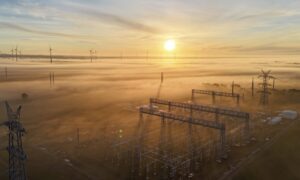The head of the Australia Energy Market Operator, Daniel Westerman, has described the recent energy crisis and market suspension as more challenging – “by an order of magnitude” – than the South Australia blackout that occurred nearly six years ago.
In a wide ranging speech to energy company bosses on Tuesday, Westerman said the main lesson from the energy crisis has been the need to accelerate the transition to renewables, and this was happening in Australia’s main grid with another boost in new generation registrations this year.
“I don’t have words to describe how challenging this period was for our operational teams,” Westerman said of the unprecedented decision to suspend the market at 2pm on June 15, after the market had proved un-manageable under the previously imposed price cap.
“Our most seasoned operators describe this as the most difficult period they’ve ever experienced,” he said. “More challenging than the cascading impact of the Callide C4 explosion a year earlier … more challenging than the system black in South Australian in 2016 … each by an order of magnitude.”
Westerman said it was clear that the best way for Australia to relieve the price spikes in the wholesale electricity market over the longer term is to break the dependency between commodity prices and electricity prices.
“And that is, of course, moving to renewable generation where the fuel is our sun, wind and water,” he said.
“Our GenCost report with the CSIRO shows wind and solar are, by far, the cheapest forms of generation. Even with the cost of new transmission & grid integration. And even in today’s environment of elevated input costs and supply chain constraints.”
The big lessons from the energy crisis had been the need for collaboration to overcome the “big hairy challenges”, particularly as the grid surges towards periods of 100 per cent renewables within three years, and for the need for more generation, more firming, and more transmission.
“It worked in this operational turmoil, it’s working to improve our connections process, and it’s how we are working towards operating the power system at periods of up to 100% renewable generation,” he said.
“Now one thing is for sure. This will not be last pothole we hit on Australia’s rapid energy transition.”
Westerman also pointed to improved connection processes as a result of its work with clean energy bodies, and the CEC in particular.
He said that in the last financial year, some 29 projects representing nearly 4GW of new generation achieved market registration. He said that was 1GW more than the previous financial year and nearly double that of the year before.
The current financial year indicates a further acceleration, with another 19 projects totalling 2.7 GW of generation are also expected to achieve market registration by the end of the year.
Among the achievements cited by Westerman was the full commissioning in June of the 530MW Stockyard Hill wind farm in Victoria, which is Australia’s largest but which has suffered heavy unexplained delays.
He also noted the commissioning of the 200MW wind component of the Port Augusta Renewable Energy Park in South Australia in August, and generation performance standards agreed for key projects such as the Golden Plains wind project in Victoria, and the 400MW Stubbo and the 330MW Wellington North solar projects in NSW.
“These are just some examples of the 149 projects, representing more than 22GW across the four connection stages,” Westerman said.
Westerman also noted that the costs of the market suspension in June had been substantially less than anticipated, and just a fraction of the $800 million reduction in wholesale electricity from the 10-day prior period.
In all, he said, compensation claims would amount to around $200 million, once the final bill had been finalised by the AEMC.








